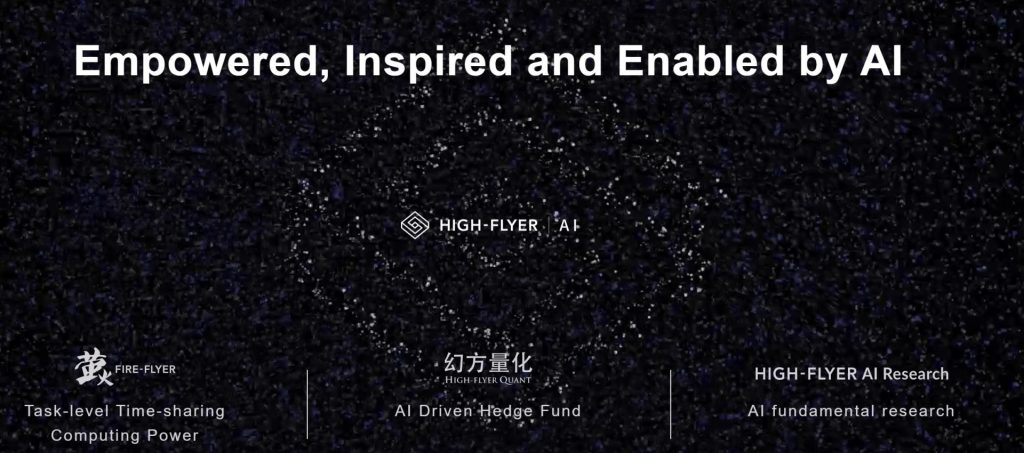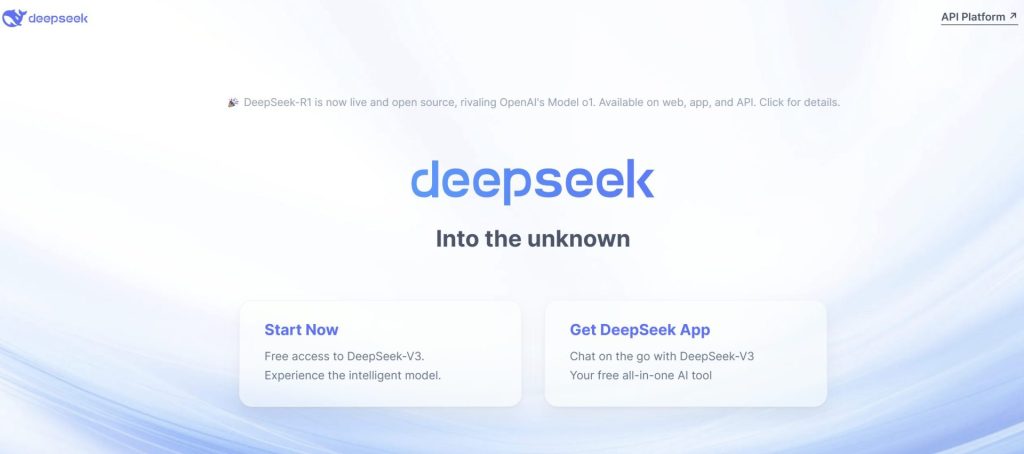Contents
Introduction:
At the intersection of technology and finance, there are always awe-inspiring innovative forces quietly emerging. With the dramatic debut of Deepseek R1—boasting powerful capabilities and a low price—this novel AI has rapidly attracted users from around the globe. Yet behind this product, which appears to come from a little-known startup, stands a formidable backer renowned in the capital markets: High-Flyer Quant. This legendary new milestone has paved the way for an unprecedented fusion of technology and finance. Much like the dark horse in an Olympic marathon who, despite a modest start, suddenly surges to catch up with the frontrunner—in this case, Deepseek, initially unassuming, is poised to nearly catch up with OpenAI through its ingenious data integration, dazzling the world with its competitive brilliance. This article explores Deepseek and the power behind it, High-Flyer Quant, from multiple angles including technology, philosophy, and prospects.
I. The Significance of Deepseek R’s Birth
In January 2025, then-U.S. President Trump, in collaboration with tech giants such as OpenAI, Oracle, SoftBank, and MGX, announced plans to invest an enormous amount of capital over the next four years to establish “Stargate.” This initiative aims to build an entirely new, globally unified high-tech ecosystem. It is not merely an investment project but an ambitious attempt to construct an end-to-end technology system—from chips and artificial intelligence to cloud computing—that would secure absolute leadership in global tech competition. Concurrently, current U.S. policies, such as restricting chip sales to China and categorizing countries (with China being placed in the third tier), clearly indicate an intent to stymie China’s rapid ascent in critical technologies and industry chains. Through the “Stargate Project” strategy, the United States seeks to consolidate high-quality global resources and establish a high-tech camp that starkly contrasts with China, thereby asserting dominance over technology, standards, and regulatory frameworks. However, once Deepseek R is launched, it will pose a formidable challenge to this global strategy.
II. What Are Deepseek and the Backing of High-Flyer Quant?
Deepseek is far more than a simple search engine or data processing platform—it is an intelligent system endowed with self-learning capabilities. At its core, Deepseek integrates deep learning algorithms with large-scale data mining technologies to intelligently analyze and predict from massive amounts of information, providing users with unprecedented information retrieval and decision-support experiences. In many ways, Deepseek represents a bold new attempt in the AI field: a shift from traditional algorithms to autonomous “thinking,” where data is transformed from cold, lifeless numbers into the very wisdom that drives decision-making. In the wake of the global AI surge sparked by ChatGPT, Deepseek’s unique positioning is particularly striking. Unlike conventional general-purpose large models, this “hybrid” creation—born from the collaboration of financial engineers and AI scientists—has carried a distinctive industry-specific character since its inception.
At first glance, Deepseek may appear to be an unremarkable startup; however, its ability to launch such cutting-edge technological products is attributable to the robust support of its parent company in China’s capital markets—High-Flyer Quant, a top-tier quantitative private equity firm. While specific figures may not be fully transparent and must be gleaned from public reports and industry analyses (for instance, reports indicate that High-Flyer Quant manages over 60 billion RMB, placing it among the leaders in the private equity space), its team is predominantly composed of R&D personnel, suggesting a strong advantage in algorithm and model development. In other words, without the backing of substantial capital and extensive data accumulation, it would be nearly impossible to develop such an advanced AI system.
Therefore, High-Flyer Quant is not only a quintessential “Invisible Capital” in China’s investment market but also one of the most powerful “Stealth Fighter” in technological exploration.
III. The Secret Behind Deepseek’s Low Cost: The Strong Support of High-Flyer Quant
Endorsed by High-Flyer Quant—which has long been a formidable force in China’s stock market and a major player in the financial sector—Deepseek R1 was able to secure ample capital and technical backing during its early R&D phase. This support allowed what would typically require a massive expenditure for deep learning training to be completed on a budget of just USD 5.58 million. Many are astounded by this low cost, which is a testament to High-Flyer Quant’s excellence in capital, resource integration, and organizational efficiency. Compared to OpenAI in the United States, where investments can run into hundreds of millions of dollars, Deepseek’s relatively “lightweight” financial footprint highlights the agility, efficiency, and profound accumulation of Chinese tech companies.
This cost disparity is not merely a matter of numbers—it reflects a strategic mindset. High-Flyer Quant employs a refined and systematic approach to capital investment. Leveraging its robust capital in the stock market and its industry-leading data advantages, it has provided Deepseek with an R&D environment that is almost entirely independent of external resources. This model enables more efficient resource allocation and fosters a virtuous cycle between technological innovation and market application. Even though the total amount of capital is significantly less than that of OpenAI, Deepseek is still able to demonstrate formidable competitiveness on the international stage through its sophisticated organizational structure and focused technical R&D.
IV. Deepseek’s Use of Data Distillation: From Wisdom Inheritance to Algorithm Optimization
In many discussions in the United States, some critics have accused Deepseek of employing “data distillation” in its data processing. However, this term has broad connotations across various fields, not limited solely to machine learning. It can be understood as the process by which humanity, through countless experiments and accumulated experience, eventually has a scientist propose an effective solution that later generations can rapidly iterate upon. Deepseek applies this very philosophy of “data distillation” to the processing of vast amounts of data—continuously filtering and refining information to extract the most valuable insights for decision-making.
In essence, Deepseek leverages highly efficient internal resource integration and meticulous management to fully realize the concept of data distillation. Throughout its R&D process, team members repeatedly distill the massive data sets, undergoing numerous experiments and optimizations to crystallize the most valuable information into actionable insights, thereby culminating in a unique technological achievement. This process mirrors the idea that after generations of exploration when a scientist finally proposes an effective solution, subsequent generations can quickly apply and build upon that breakthrough to drive further innovation.
V. Deepseek and High-Flyer Quant Combined: Surpassing Traditional Data Analysis
In today’s market, relying on a single data source is no longer sufficient for accurately grasping the intricacies of complex market behaviors. Recognizing this, Deepseek has embarked on an ambitious initiative to incorporate over 200 types of alternative data—ranging from satellite imagery to supply chain data—by deeply mining order flow data to reconstruct trader behavior profiles and simulate the interactive decision-making processes of over 100,000 market participants.
This multi-dimensional data integration and large-scale behavioral simulation strategy epitomizes the unique insights of Chinese developers and pioneers in the stock market’s tech arena. They understand that traditional data analysis methods often fall short when faced with rapidly changing market conditions. By leveraging alternative data and behavioral mapping, they can more accurately capture market trends, predict risks in advance, and optimize investment strategies. In this respect, Chinese developers display keen market insight and an extraordinary innovative spirit in technical practice. Their approach not only represents an optimization of algorithms but also symbolizes the inheritance of wisdom and knowledge, each iteration is a recreation of previous generations’ insights and a cornerstone for future innovation.
Conclusion:
The U.S.-dominated high-tech ecosystem is designed to maintain absolute superiority in key technological areas, safeguarding national security and international influence. Its anticipated benefits include technological leadership, standard-setting power, supply chain stability, and geopolitical advantages. However, it also faces immense challenges from emerging competitors in China, whose technological innovations are rapidly altering the landscape. If Chinese enterprises can continue to drive technological innovation and swiftly overcome existing blockades and restrictions, the new order envisioned by “Stargate” could suffer severe disruption, potentially necessitating a complete realignment of the global tech order.




